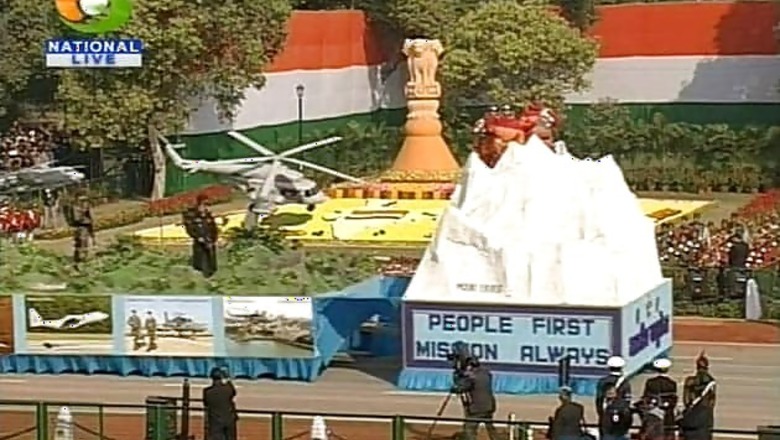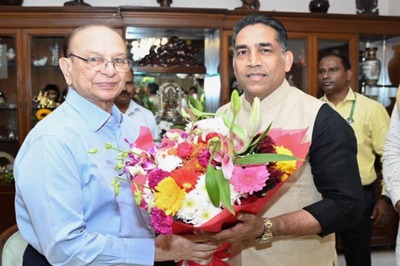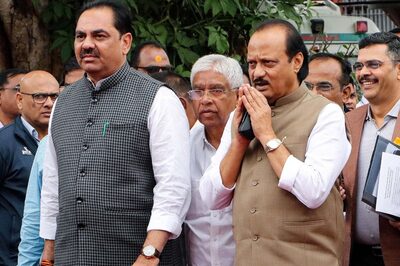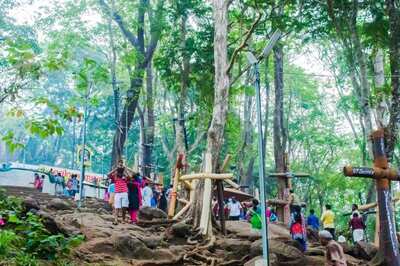
views
New Delhi: India celebrated its 63rd Republic Day on Thursday with a fabulous show of military might and cultural splendor. The main ceremonial parade was held in the capital with Thailand's first woman Prime Minister Yinluck Shinawatra as the guest of honour. What made the celebration even more special was that for the first time, women led the Air Force contingent at the Republic Day parade.
Sneha Shekhawat from Sikar in Rajasthan created history when she led the Air Force contingent at the 63rd Republic Day parade becoming the first woman pilot to do so.
Flight Lieutenant Shekhawat was assisted by three other women Flying Officers Heena Pore, Anupam Chaudhary and Pooja Negi as the 144-strong Air Force contingent marched to the tunes of 'Air Battle'.
She was cheered by thousands of spectators as the commentator mentioned that she is the first woman to lead an Air Force contingent in the 63-year-old history of the parade.
Shekhawat is at posted with the IAF squadron at Hindon air base.
The ceremony began around 10 am with Prime Minister Manmohan Singh laying a floral wreath at the Amar Jawan Jyoti to pay tribute to an unknown soldier.
The early morning chill did not deter people along the 8-km-parade route as they gathered on both sides of the majestic Rajpath, the country's ceremonial boulevard facing the Raisina Hills, and cheered the contingents as they went past portraying the diverse culture of the country.
The well-turned out and synchronised military and police formations led by General Officer Commanding (Delhi) Lt Gen VK Pillai marched proudly to the lilting tunes of bands through the Rajpath where President Pratibha Patil, who is the Supreme Commander of Armed Forces, took salute.
The impressive march-past was watched by Chief Guest Thai Prime Minister Yingluck Shinawatra, Vice President Hamid Ansari, Prime Minister Manmohan Singh, Defence Minister AK Antony, UPA Chairperson Sonia Gandhi, Marshal of Air Force Arjan Singh and top political and military brass.
Police and other para-military forces turned Delhi into a a virtual fortress for the Republic Day celebrations as helicpoters scanned from air, snipers kept a hawk-eye vigil from rooftops and armed personnel at every nook and corner provided a ground-to-air security apparatus.
Minutes before the parade began, Singh, Antony and chiefs of Army, Navy and Air Force laid wreaths at 'Amar Jawan Jyoti', an eternal flame in the memory of those who laid down their lives while defending the nation.
After the customary 21-gun salute and unfurling of the national tricolour, President Patil presented Ashok Chakra - the highest peacetime gallantry award - posthumously to Lieutenant Navdeep Singh who died foiling an infiltration attempt by Pakistan-based terrorists along the LoC in Jammu and Kashmir.
Then, four Mi-17 helicopters zoomed in from skies on the western side showering flower petals on thousands of spectators, signalling the start of the impressive parade followed by winners of Param Vir Chakra, highest war-time gallantry award, and Ashok Chakra and mounted columns of 61 Cavalry.
The Army showcased its impressive weaponry which included T-72 tanks, Carrier Motor Tracked vehicle, Smerch missile Launcher, Multi Barrel Rocket System 'Pinaka' and Full Width Mine Plough.
It also displayed the NBC (Nuclear- Biological-Chemical) Chemical Purification System and Jammer Station.
Demonstrating its air power, Army's also conducted a flypast of three indegenously made advanced light helicopters Dhruv.
The Army contingent from Parachute Regiment, Bengal Engineer Group, The Brigade of the Guards, Kumaon Regiment, Assam Regiment, Mahar Regiment and Gorkha Rifles marched to the tunes of 'Arjuna', Thimmaya, 'Gangotri' and 'Veer Gorkha' military numbers.
The next to follow were smartly-dressed Navy personnel and then the Air Force contingent, led by Flight Lieutenant Sneha Shekhawat, marching to the tunes of 'Jai Bharati' and 'Air Battle'.
The Navy showcased models of the Delhi Class guided missile destroyer and IL-38 (Sea Dragon) Long-Range Maritime Reconnaissance aircraft.
The 3,000-km-range nuclear-capable Agni-IV missile, successfully flight tested in November last year, stole the limelight as people cheered and clapped when the weapons system's model came near them. Commentaries gave an insight into the capabilities of the sophisticated missile system.
The DRDO also put on display for the first time the 150-km range Prahaar tactical battlefield support missile and the Rustom-1 Unmanned Aerial Vehicle (UAV).
Other marching contingents were those of camel-mounted BSF, Assam Rifles, Coast Guard, CRPF, ITBP, CISF, SSB, RPF, Delhi Police, NCC and NSS.
As the country's armed and police forces demonstrated their might, states and different departments put up an impressive show when they showcased their rich cultural diversity in full display in 23 tableaux - 13 from states and ten from ministries.
Another highlight of the event was that West Bengal became part of the parade after 13 years as it showcased the university town of Shantiniketan, the living abode of Rabindranath Tagore, that symbolises the avant garde vision of an international, educational and cultural institution.
The Jammu and Kashmir tableaux depicts the architectural heritage of its capital Srinagar during the medieval period, while Chhatisgrah showcased the Dondaki art and claywork by artists late Sonabhai Rajwar, Darogaram and Atmadas Manikpuri.
The one by Maharashtra boasted of its rich culture, natural wonders and historical monuments and attractive tourist destinations.
The north-eastern state of Meghalaya depicted the Jaintia Festivals and the most colourful dance by the major tribal community inhabiting the state, while Rajasthan brought alive the 'Aamber Fort' which has an unique artistic style that blends both Hindu and Mughal elements.
Assam showcased its enthralling Bhortal dance, while the Punjab tableaux adorned the larger than life figure of Sher-e-Punjab Maharaja Ranjit Singh atop the Lahore fort.
Goa, Nagaland and Sikkim are other states who showcased their cultural heritage.
The Union Textiles Ministry's tableaux displayed the range of Indian handicrafts, reflecting the journey of Indian handicrafts from the traditional to the modern world, representing the rich cultural heritage from Kashmir to Kanyakumari.
The HRD Ministry came up with 'Saakshar Bharat' depicting an aspirational goal- a society that is fully literate.
'Punjab Mail', the first train of the Indian Railways to achieve the distinction of entering its 100th year of service, was the topic of Railways tablueax.
Election Commission which came with a tableu for the first time had 'National Voter's Day' as its theme which publicises the objective to maximise enrolment of voters and thereby enhance the quality of Indian democracy.
Tribal Affairs Ministry, CPWD, Finance Ministry, Agriculture Ministry, Ministry of Communication and Information Technology, and Steel also showcased their achievements.
More than 450 artists, fabricators and designers living in the special artist village are involved in the making of these tableaux.
Following the tableaus, 21 young brave hearts who won the national bravery awards drove through the Rajpath in gypsies to a huge applause following which 1,200 students enthralled the spectators with a spectacular performance of various dance forms.
Students between the age group of 12 years to 20 years from West Bengal, Orissa, Delhi and other states performed five cultural programmes during the parade.
A folk ritual from Tamil Nadu to please the goddess of health and rain, fisherman dance from Maharashtra and a ritual related to Odisha were among the highlights of youngsters' performances.
Based on the ideals of meaningful education of Mahatma Gandhi, students of Kendriya Vidyalaya in Delhi's RK Puram presented an item on mass literacy.
Through their song and formation they invoked a world where every person is educated in letter and spirit, where everyone would touch the height of prosperity and enlightenment.
Students of Government Sarvodaya Vidyala in Hastsal brought the colourful 'Kodiyancha Karavan', a folk dance of Maharashtra fishermen while another group presented 'Karagam', a folk dance of Tamil Nadu which originated as a ritual dedicated to Mariamman, the goddess of health and rain.
Another performance was that of 'Thakurani' - a combination of 'Animal Dance', 'Ranapa Dance' and 'Jodi' - which is connected with the religious procession of Thakurani Jatra in Ganjam district of Odisha.
'Gudum Baja', a traditional tribal dance in Mandla and Shahdol Districts of Madhya Pradesh, was also showcased during the parade.
A breathtaking dare-devil performance from the BSF motorcycle team 'Janbaz' then took the breath out of the spectators.
154 riders on 30 motorcycles performed Bordermen Salute, Side Riding, Yoga, Janbaz-1, Ladder Double, Harmony, Exercise, Pyramid, Parallel Bar, Guldasta, Karvan and Flag March.
The grand finale of the parade was the spectacular flypast by the IAF, with the C-130J Super Hercules aircraft participating in the parade for the first time.
The flypast was led by a Vic formation of three Mi-35 helicopters, followed by the three Super Hercules again in a Vic formation. Trailing them was an IL-78, flanked by two AN-32 and two Dornier, in a Big Boy formation and next in line was the fighters, - five Jaguars followed by five MiG-29 will fly in Arrowhead formation.
The breathtaking Trishul formation comprising three Su-30 MKI would fly over the Rajpath and once in front of the saluting dais the Su-30MKI aircraft split upwards, making a Trishul in the sky. The flypast concluded with another Sukhoi
Su-30 MKI carrying out a Vertical Charlie manoeuvre over the saluting dais.
(With additional information from agencies)




















Comments
0 comment